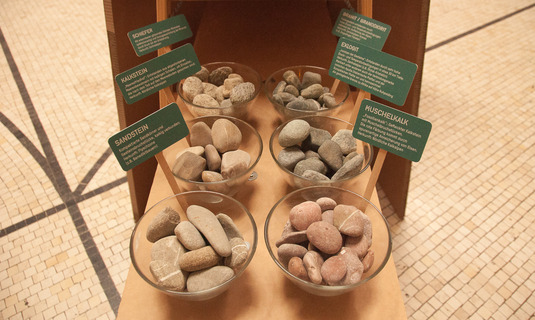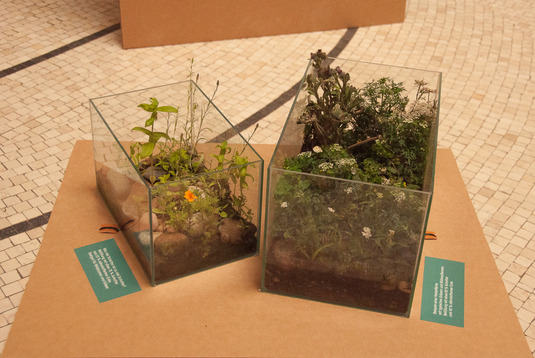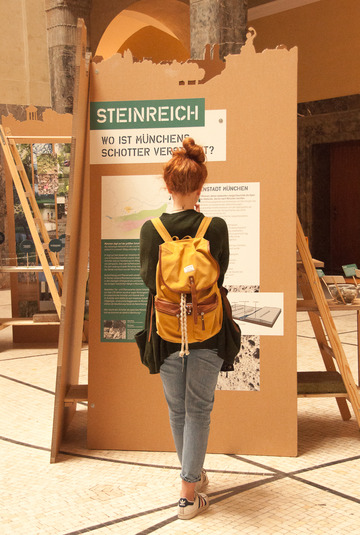Ecopolis Munich Exhibition/“Stone-Rich”
Where is Munich’s Gravel Hiding?
18.09.2017
This project by Alicia Dorner and Stefan Bitsch, students of the RCC-LMU Environmental Studies Certificate Program, stems from research conducted as part of the exhibition project “Ecopolis: Understanding and Imagining Munich’s Environments.”
Looking for Gravel at the banks of the Isar. Photo Credit: Alicia Dorner and Stefan Bitsch.
Munich is situated on the largest gravel plain north of the Alps.
Although rather unassuming, gravel is a versatile raw material
that is present in our everyday lives and characterizes Munich’s cityscape.
It is scattered across the grounds of popular beer gardens
and is a basic component in our streets and houses.
Gravel is used in the production of everyday objects,
from toothpaste and glass to coffee cups.
Through the products they use, every Munich resident goes through about
seven tons of sand and gravel per year from the city’s gravel plain.
Gravel also influences soil formation and vegetation.
In the flat countryside surrounding Munich, rivers and streams
cut into the rocky subsoil and thereby form
the city’s only natural slopes.
Gravel provides a habitat for endangered animals and plant species.
More than 130 years ago, a gravel pit became a refuge for humans.
In gravel, an eccentric artist and visionary found
a place for his creative work.
Inoperative and renaturalized gravel pits in Munich’s countryside
are now open as recreational areas to inhabitants, as well as to endangered species.
What makes gravel a typical Munich rock?
And how do we connect with it?

Munich's different gravel types. Photo Credit: Florin Pruna.
Munich: An Alpine City
Over two million years ago, enormous ice sheets covered the Alps
and formed glaciers that stretched all the way to Munich.
Some of our recreational areas, like Lakes Ammer and Starnberg,
are the remnants of advancing glacier tongues.
The ice carried away vast amounts of rock mass from the Alpine peaks,
and glacial rivers like the Isar transported boulders
further north towards the Danube.
Thus a typically flat and barren gravel plain developed,
in the middle of which Munich was later built.
Munich grew on the slopes of the Isar terraces.
Low-lying places, like Sendling, flooded often
and so were reserved for the poorer inhabitants;
whereas, the higher-situated city center of the old town protected the elite.
Munich residents faced the floods with
customized architecture made of Nagelfluh.
The word Nagelfluh is German in origin. It refers to a chalky rock that consists of gravel,
which was removed on a large scale from the slopes of the Isar.
A highly porous and stable building material,
it is ideally suited to the base of large buildings.
After a flood, water is able to drain quickly,
without compromising the rock’s strength.
Layers of clay lie beneath the Nagelfluh in the stratigraphy;
bricks were formed from this clay and used for the upper stories of buildings.
One example is Munich’s municipal district “Berg am Laim.”
Historic buildings still contain this classical construction.

The experiment: Who can live on gravel? Photo Credit: Florin Pruna.
Who Can Live on Gravel?
Gravel forms low-nutrient ground
in which it is difficult for most plant life to thrive.
However, gravel offers ideal conditions for
undemanding heathers and heath plants like chamomile, daisy, and birch.
The gravel pits are an ecological niche for displaced animal species
and several specially adapted species find refuge here.
The little ringed plover shies away from the hustle and bustle along the banks of the Isar
and instead escapes to the gravel pits around Munich.
What characterizes these special landscapes?
A Naked Visionary in Gravel
Karl Wilhelm Diefenbach was a nineteenth-century artist
whose opinions caused a stir throughout Munich.
He appeared nearly every Sunday and
openly flaunted and “preached” naturalness, freedom, and vegetarianism.
Furthermore, he questioned strict monogamy.
Many contemporaries in heavily Catholic Munich
considered his ideas to be strange, at best, and scandalous, at worst.
They ridiculed him and his “disciples” as “kohlrabi apostles.”
Because of his naked proclamations at Marienplatz,
he was exiled from the city in 1885.
From that point on, he lived at a Nagelfluh quarry
south of Munich for several years, in the small town of Höllriegelskreuth.
Diefenbach became an icon for the nudist movement in Germany and
set a new standard in terms of modern aesthetics—
an early contribution to changed body awareness.

The project at the Ecopolis Exhibition. Photo Credit: Florin Pruna.

